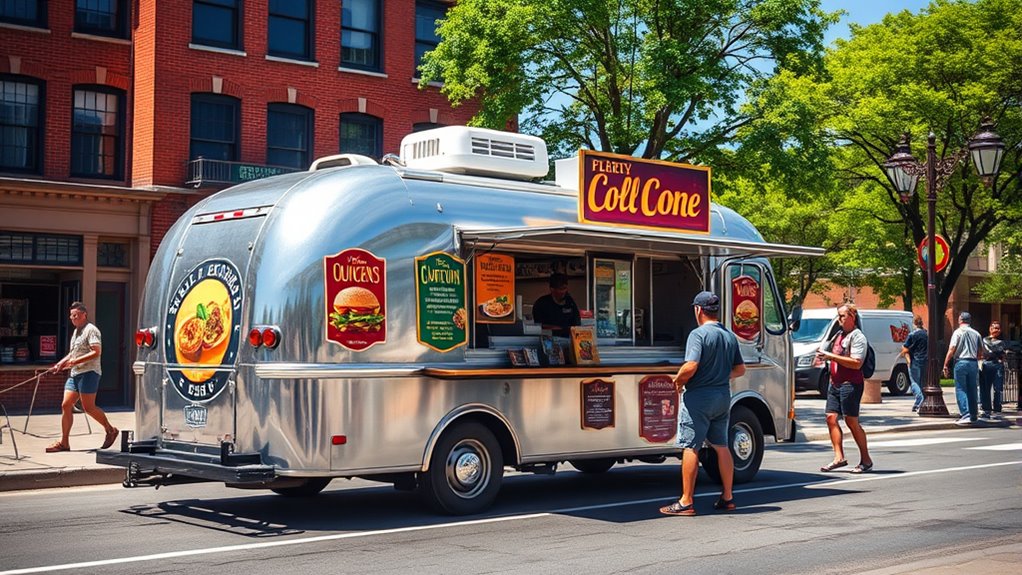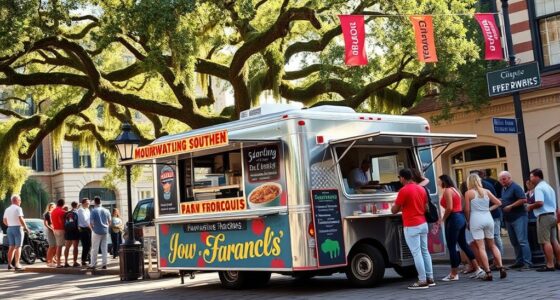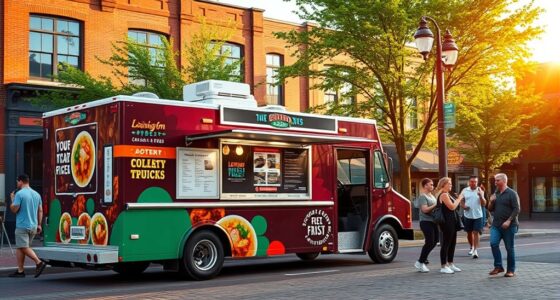To open a food truck in Sacramento, you’ll need to secure a Mobile Food Facility permit from the county, which involves inspections, paperwork, and renewal fees. Budget around $50,000 to $175,000 for your vehicle, equipment, permits, and initial supplies. Focus on high-traffic locations like Downtown, Midtown, or festivals, and develop a menu with diverse, appealing options. Effective marketing on social media and local events will boost your visibility; further tips are just ahead.
Key Takeaways
- Obtain and renew a Mobile Food Facility (MFF) permit from Sacramento County, ensuring compliance with vehicle safety, food safety, and inspection requirements.
- Budget $50,000–$175,000 for vehicle, equipment, permits, licenses, insurance, initial inventory, and marketing expenses.
- Target high-traffic locations like Downtown, Midtown, transit hubs, and events such as festivals and tourist spots for optimal visibility.
- Develop a diverse menu featuring regional or international cuisines, signature dishes, and options tailored to local tastes and dietary preferences.
- Promote your food truck via social media, customer reviews, locator apps, local events, and engaging content to build brand awareness and customer loyalty.
Navigating Permits and Licensing in Sacramento
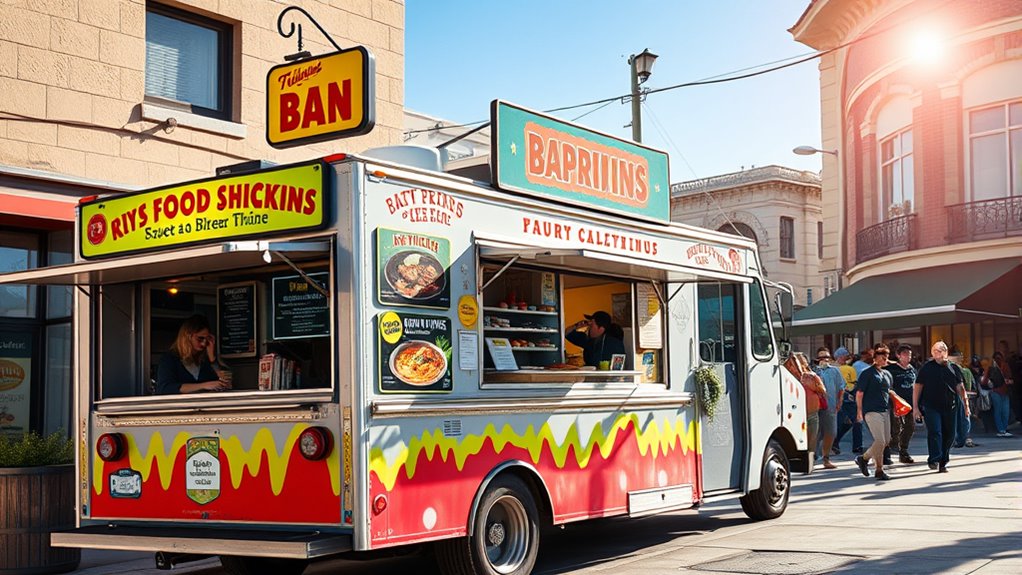
Navigating permits and licensing in Sacramento can seem complex, but understanding the requirements is essential for a successful food truck operation. You’ll need a Mobile Food Facility (MFF) permit, renewed annually, with categories based on your vehicle type and operation style. For example, Category D permits require proof of prior permits in California or detailed plans before construction. Your application must include forms like the Permit Application, Commissary Form, Route Sheet, and Restroom Verification if operating over an hour at a location. You’ll also need to schedule inspections with the Sacramento County Environmental Management Department, which reviews vehicle safety, food safety procedures, and equipment. Be prepared to display your permit sticker visibly on your truck, and remember, permits are valid only within Sacramento County. Permit renewal requirements vary depending on the specific category and your operational history.
Estimating Startup Expenses and Budget Planning
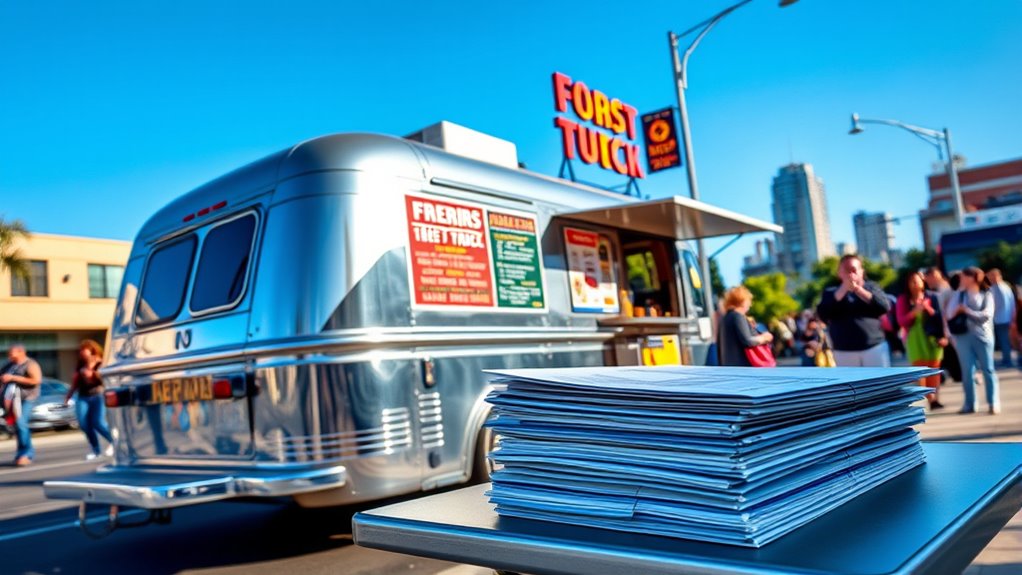
Understanding your startup costs is a pivotal step in planning a successful food truck business in Sacramento. You’ll need to estimate expenses across several categories. Vehicle and equipment costs vary widely, from $30,000 for used trucks to up to $300,000 for custom builds, plus $10,000–$30,000 for kitchen installation and POS systems costing $200–$5,000. Vehicle costs are highly dependent on whether you buy new, used, or lease, impacting your initial investment. Additionally, considering the cost of permits and licenses** is crucial, as these can significantly influence your overall budget. Permits, licenses, and insurance typically total $3,000–$10,000, with Sacramento’s fees including business registration, health permits, and $2,000–$5,000 annual insurance. Initial inventory and supplies can cost $1,000–$5,000, plus $300 or more for disposables, and monthly fuel, maintenance, and marketing expenses add up. Overall, plan for $50,000–$175,000, considering funding options** like loans, savings, or investors to cover these costs.
Prime Locations to Launch Your Food Truck Business
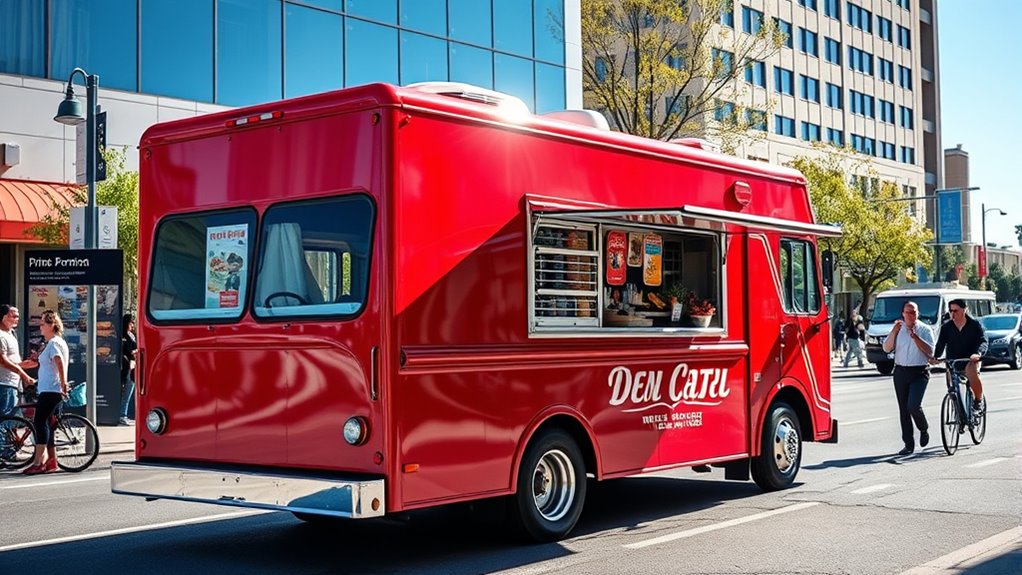
Choosing the right location is essential for your food truck’s success in Sacramento. High-traffic urban areas like Downtown and Midtown draw office workers, tourists, and nightlife crowds, offering prime lunchtime and evening sales. Near the California State Capitol, you’ll find consistent foot traffic from visitors and protesters. Residential neighborhoods like Land Park and Curtis Park provide weekend opportunities, while proximity to transit hubs like Sacramento Amtrak Station increases visibility among commuters. Food truck parks such as Madison Food Park and shared markets in parks or community events offer built-in audiences. Festivals, concerts at Cesar Chavez Plaza, and events at Golden 1 Center attract large crowds. Tourist spots like Old Sacramento, Sutter’s Fort, and family attractions generate steady daytime demand. Sacramento has a vibrant food truck scene emerging alongside its well-established culinary reputation. Strategic locations are key to establishing a thriving Sacramento food truck business, especially in areas with urban foot traffic and high visibility.
Crafting a Menu That Attracts and Retains Customers

Crafting a menu that attracts and retains customers requires a strategic blend of variety, authenticity, and innovation. To stand out, consider these key elements:
- Offer diverse options, like regional or international cuisines, to appeal to broader tastes.
- Incorporate authentic flavors and traditional recipes to build a strong brand identity and loyalty.
- Include dietary choices such as vegetarian, halal, or healthy options to attract niche markets.
- Introduce signature or seasonal items—think roasted meats or special sauces—that create memorable experiences.
- Understanding local preferences can help tailor your menu to better meet the specific tastes and cultural influences of Sacramento’s diverse community. Additionally, staying informed about consumer trends can help you adapt your offerings to current market demands and preferences.
Effective Marketing and Customer Engagement Strategies
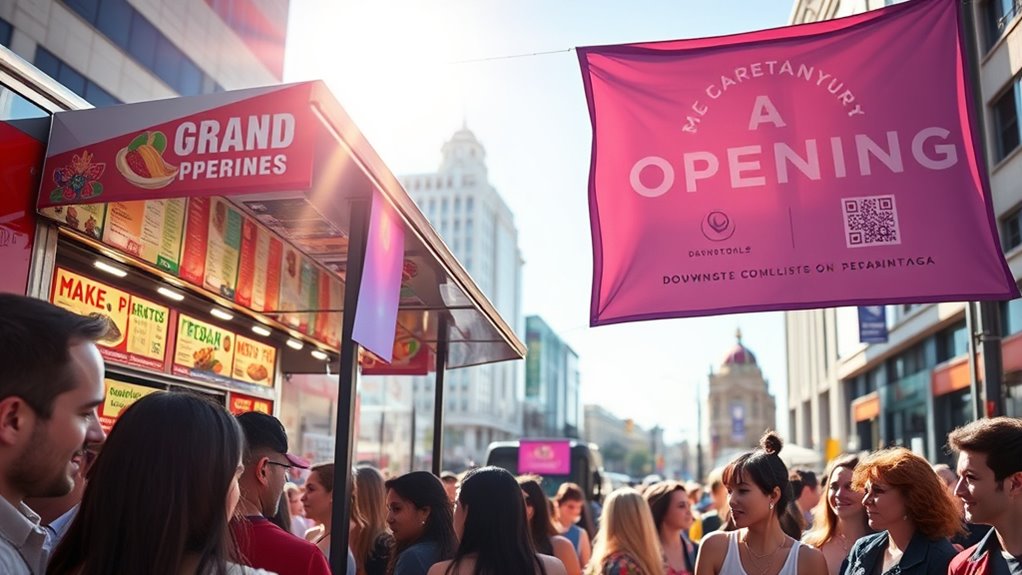
Once you’ve developed a compelling menu, the next step is to make sure customers know about it and keep coming back. Leverage social media by sharing high-quality photos and videos of your food to boost visibility. Platforms like Facebook, Instagram, TikTok, and YouTube help create strong engagement and word-of-mouth buzz. Encourage customers to post reviews and tag your truck, adding organic promotion and social proof. Use AI tools to automate posts and manage ads for wider reach. Share behind-the-scenes content and cooking techniques to build a unique brand personality. Additionally, strategically choose high-foot-traffic locations and register on food truck locator apps to attract nearby customers. Use push notifications for updates, and monitor analytics to optimize your location and timing for maximum engagement. According to recent community events, participating in local initiatives can also increase your visibility and foster community support. Implementing targeted email marketing campaigns can further enhance customer retention and promote special offers.
Frequently Asked Questions
How Long Does It Typically Take to Obtain All Necessary Permits in Sacramento?
Getting all your permits in Sacramento usually takes several weeks to 2-3 months. You’ll need to submit your application, pass inspections, and complete plan reviews if building or remodeling. The timeline depends on how prepared you are, how quickly you schedule inspections, and if any issues arise during review. Planning ahead and ensuring your paperwork is complete can help speed up the process and avoid delays.
Are There Specific Zoning Restrictions for Food Trucks in Residential Neighborhoods?
Think of zoning restrictions like guardrails guiding your food truck journey. In Sacramento, residential neighborhoods are off-limits for mobile vending—you can’t operate directly on residential property. You’ll need to park on public spaces, stay away from outdoor dining areas, schools, and entertainment venues, and follow strict distance rules. These restrictions protect neighborhood peace, so make sure to plan your routes and locations carefully to stay within the lines.
What Are the Insurance Requirements for Food Truck Businesses in Sacramento?
You need to meet specific insurance requirements for your Sacramento food truck. This includes having general liability insurance to protect against customer injuries or property damage. You also must carry commercial auto insurance to cover your vehicle, and if you have employees, workers’ compensation insurance is required. Additionally, a Business Owner’s Policy can bundle coverage for property and liability, ensuring your business stays compliant and protected during operations and parking in the city.
How Can I Find Affordable or Financing Options for Truck Purchase or Rental?
You might think buying or renting a food truck is costly, but financing options prove otherwise. Investigate equipment financing, leasing with FMV options, and promotional programs that lower initial payments. You can also explore partnerships with lenders offering low or zero down payments, deferred payments, or flexible monthly plans. Many lenders tailor solutions to your financial situation, helping you access affordable trucks and rentals while preserving your cash flow.
What Are the Most Profitable Seasonal Times to Operate a Food Truck in Sacramento?
You’ll find the most profit when you operate during Sacramento’s peak seasons, mainly spring and summer. During these months, outdoor festivals, farmer’s markets, and tourist influx boost sales. Additionally, the holiday season from Thanksgiving to New Year brings increased catering opportunities. Focus your efforts in these periods, especially on evenings and weekends, to maximize customer flow and revenue, adapting your schedule to seasonal event calendars for ideal results.
Conclusion
With the right permits, a killer menu, and a marketing plan, your food truck can become the hottest thing on every Sacramento street corner. Imagine crowds lining up like it’s a festival, your truck bursting with flavors that turn heads and mouths watering. If you master these steps, you’ll transform your small startup into an unstoppable culinary empire, making your food truck the stuff of legend across the city—everyone will be talking about it!
